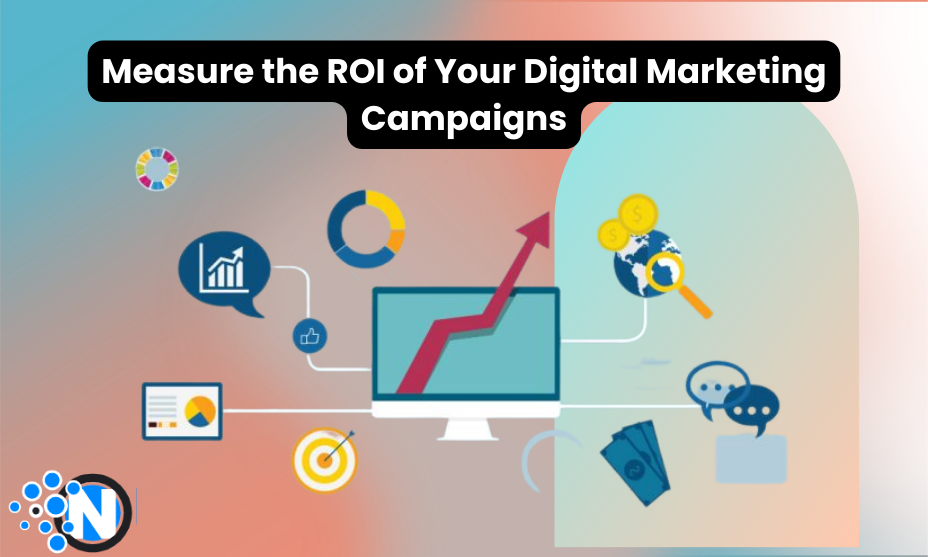How to Measure the ROI of Your Digital Marketing Campaigns

Businesses invest a lot in digital marketing strategies to drive growth and effectively reach their target audience. However, just implementing costly marketing campaigns is not enough. To ensure these endeavors’ success and profitability, measuring the ROI they generate is vital. Measuring ROI lets businesses assess the effectiveness of their digital marketing efforts, make informed decisions, and optimize their strategies for better outcomes.
In this blog post, we will share various methods and tools that can help you measure the ROI of your digital marketing campaigns effectively and make necessary changes to grow greatly.
Defining ROI in Digital Marketing
Before embarking on the measuring techniques, let’s first understand the ROI of digital marketing. ROI, or return on investment, is a metric that estimates the profitability of an investment relative to its cost. In digital marketing, ROI is the return generated from your marketing activities compared to the resources and costs spent on them. This may include time, money, cost of tools and skills.
Key Metrics for Measuring Digital Marketing ROI
To measure the ROI of your digital marketing strategies, you should track and analyze specific key metrics. These metrics provide valuable insights into the performance and effectiveness of your marketing efforts. Below are some essential metrics that can help you calculate the ROI of your campaigns:
1. Conversion Rate
The conversion rate is the percentage of website visitors who perform a desired action on a website, such as purchasing, filling out a form, or subscribing to a newsletter. You can determine how well your marketing campaigns drive the desired results by tracking the conversion rate.
2. Cost per Acquisition (CPA)
Cost per Acquisition (CPA) calculates the average cost incurred to acquire a customer or lead. It helps you understand the efficiency of your marketing spend and allows you to compare different channels or campaigns based on their performance in acquiring new customers.
3. Customer Lifetime Value (CLV)
Customer Lifetime Value (CLV) estimates the total revenue a customer will generate throughout their relationship with your business. By analyzing CLV, you can assess the long-term profitability of your marketing efforts and make informed decisions regarding customer acquisition and retention strategies.
4. Return on Ad Spend (ROAS)
Return on Ad Spend (ROAS) measures the revenue generated from your advertising campaigns relative to the amount spent on those campaigns. ROAS provides insights into the effectiveness of your advertising channels and helps you optimize your ad budget allocation.
5. Click-Through Rate (CTR)
Click-Through Rate shows the percentage of people who click on your ad or email link compared to the total number of impressions. CTR is a valuable metric for assessing the relevance and attractiveness of your marketing messages, as higher CTR indicates better engagement with your audience.

Tools to Measure Digital Marketing ROI
Numerous tools are available to simplify the process of measuring and analyzing your digital marketing campaigns’ ROI. These tools come with advanced analytics and reporting capabilities that enable you to track the key metrics we discussed earlier.
Here are some popular tools you should consider when measuring the ROI of your digital marketing campaigns:
1. Google Analytics
Google Analytics is a popular and powerful web analytics platform that offers complete insights into your website’s performance. It helps you to track website traffic, user behavior, conversion rates, and other important metrics. Using Google Analytics for your marketing campaigns helps you better understand their overall impact on your ROI.
2. CRM Software
Customer Relationship Management or CRM software facilitates you to track and manage customer interactions throughout their relationship with your business or company. These platforms provide valuable data on customer behavior, lead generation, revenue generated and sales, which can be useful in calculating and improving your digital marketing ROI.
3. Social Media Analytics Tools
Tools like Sprout Social, Hootsuite, or Buffer provide detailed analytics and reporting features for businesses heavily invested in social media marketing. These tools allow you to track engagement metrics, audience demographics, and campaign performance across various social media platforms.
4. Marketing Automation Platforms
Marketing automation platforms offer advanced features for tracking and measuring the ROI of your email marketing strategy. With these platforms, you can monitor open rates, click-through rates, conversion rates, and other metrics related to your email marketing efforts.
Implementing a Digital Marketing ROI Measurement Strategy
Now that we’ve covered the key metrics and tools let’s discuss the steps to implement an effective digital marketing ROI measurement strategy:
Step 1: Set Clear Goals and Objectives
Before launching any digital marketing campaign, defining clear goals and objectives is crucial. Determine what you aim to achieve with your campaign: increased sales, lead generation, brand awareness, or customer engagement. Clearly defined goals will provide a foundation for measuring ROI accurately.
Step 2: Define Conversion Points
Identify the key conversion points within your digital marketing funnel. These conversion points could be a completed purchase, a form submission, or any other action that aligns with your campaign objectives. By tracking these conversion points, you can measure the effectiveness of your campaigns in driving desired outcomes.
Step 3: Implement Tracking Mechanisms
Leverage the tools we discussed earlier to implement robust tracking mechanisms. Set up conversion tracking pixels, utilize UTM parameters for campaign URLs, and integrate your marketing channels with analytics platforms. These mechanisms will help you to collect accurate data and measure the effectiveness of your campaigns.
Step 4: Analyze and Optimize
Regularly analyze the data collected from your tracking mechanisms. Identify trends, patterns, and areas of improvement. Use A/B testing to test different marketing strategies and optimize based on the insights found. Continuous analysis and optimization will help you maximize the ROI of your digital marketing efforts.
Ending Note
ROI measurement of digital marketing is important to see how well you achieve your marketing goals without breaking the bank. This also helps you eliminate the strategies that are underperforming. Hence, you should use the right tool to measure the key metrics for better outcomes.




